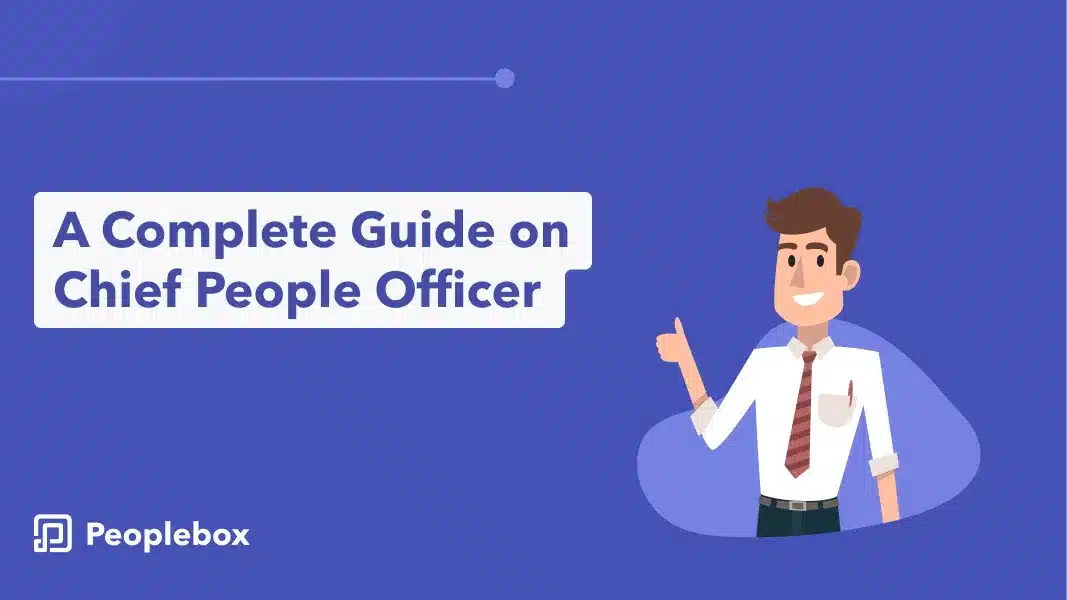Employees are the driving force behind innovation, productivity, and success. Recognizing the importance of its people, all modern business organizations are investing in and nurturing a talented workforce.
But how can a company do that?
Simple, by appointing a CPO.
So, what is a CPO?
A CPO or Chief People Officer serves as a strategic leader, entrusted with the responsibility of optimizing the potential of an organization’s human capital.
With a deep understanding of the value of employees, the CPO spearheads the human resources department, ensuring that the right individuals are recruited, retained, and developed to drive the organization’s growth and prosperity.
A highly engaged and skilled workforce is indispensable for long-term success. The CPO’s pivotal role involves aligning human resources strategies with overarching business objectives. They strive to foster a positive work environment that ignites productivity, cultivates loyalty, and sparks innovation.
In this blog, we will provide you invaluable insights into the world of Chief People Officers and their profound impact on shaping thriving and resilient businesses.
Key Objectives of a CPO
The key objectives of a CPO revolves around maximizing the potential of the organization’s human capital. These objectives typically include:
- Developing and shaping the people strategy of a company, which includes hiring practices, leadership development, and training programs.
- Establish the goal-setting & performance management process
- Establish and uphold effective strategies for onboarding and offboarding employees.
- Enhancing and fine-tuning recruitment policies to attract and retain top talent.
- Taking charge of managing employee benefit programs to enhance overall employee satisfaction and engagement.
- Assisting in the creation of succession plans to ensure smooth transitions in key roles.
- Supervising and managing communication initiatives across the entire company to keep employees informed.
- Collect feedback on employee well-being and productivity to guide the strategies for developing company culture.
What Does A Chief People Officer Do?
1. Managing and Developing People Strategy

The CPO plays a critical role in developing and overseeing the overall strategy for people operations within a company.
This involves various areas like strategic planning for people development, leadership development and ensuring the alignment of human resources functions with the organization’s business goals.
- The CPO collaborates with the leadership team to consolidate different HR functions into a cohesive unit that effectively supports the achievement of strategic objectives.
- The CPO also plays a role in budget development that aligns with the people strategy.
- The CPO holds the responsibility of establishing HR policies in accordance with corporate objectives, aiming to create an environment that nurtures employee growth and success. This includes identifying key areas for improvement, setting strategic goals, and outlining initiatives to enhance the overall effectiveness of the workforce.
2. Overseeing recruitment and the right talent acquisition
According to a survey, 30% of new hires leave within 90 days because of various reasons. The same survey dictates that the turnover cost is 33% of an employee’s salary along with a productivity drop.
A CPO plays a critical role in overseeing the recruitment process and ensuring the acquisition of the right talent for the organization. This also involves avoiding scenarios that lead to new hire retention and efficiency.
This entails developing and implementing effective talent acquisition strategies that align with the company’s values, goals, and workforce requirements. This includes:
- Collaborating with the HR teams and hiring managers to develop a comprehensive talent acquisition strategy. This involves defining the required skill sets, qualifications, and cultural fit necessary for each position within the organization.
- Identifying and leveraging various recruitment channels, such as job boards, social media platforms, professional networks, and recruitment agencies, to attract diverse and highly qualified candidates.
- Establishing standardized evaluation processes and criteria to assess candidate’s qualifications, experience, and potential.
- Collaborates with managers to ensure that internal promotions and transitions are supported by proper preparation and readiness.
- The CPO collaborates with HR and other relevant departments to ensure a smooth onboarding process for new hires, facilitating their integration into the company culture and setting them up for success from day one.
- Along with hiring, the CPO also promotes employee retention by gathering turnover data, and proactively addressing employee questions and concerns.
3. Present the company as the preferred employer among job seekers
A CPO strategically positions the company as the preferred employer among job seekers, to attract and retain top talent. This ultimately contributes to the organization’s long-term success and growth.

- Develop and implement employer branding strategies like highlighting the organization’s mission, vision, and values to create a compelling and attractive employer brand identity.
- Showcase the company’s unique culture and opportunities.
- Enhance the candidate experience throughout the recruitment process like streamlining the application process, providing timely feedback, and creating a welcoming and inclusive interview experience.
- Establish partnerships with external organizations and professional networks to expand reach and reputation.
- 86% of employees look at company reviews and ratings before applying for a job. A CPO will craft a thoughtful strategy to leverage employee testimonials and success stories on various online employee websites.
- Pursue employer awards and recognition that highlight the organization’s accomplishments as an employer.
4. Develop and implement the compensation strategy and benefits program
Just as the recruitment strategy, the compensation strategy also plays a crucial role in defining the competitive edge and growth trajectory of a company.
Once the roles are decided, their significance and contribution to mutual success are established; the CPO establishes an optimal salary range for every position. This involves a comprehensive assessment that takes into account various factors, including experience level, geographical location, job type, and more.
The CPO collaborates with finance and executive teams to design a compensation strategy that ensures fair and competitive pay structures for employees. This strenuous process encompasses conducting market research, analyzing industry benchmarks, and considering internal equity to establish appropriate salary ranges and incentives.
5. Implementing performance management systems and overseeing the process
The CPO holds the crucial responsibility of ensuring that employees meet organizational goals and KPIs. This involves designing performance evaluation processes, delivering feedback, creating development opportunities for improvement and most importantly, implementation of a performance management system.
Performance management includes methods like 360-degree assessments, feedback sessions with managers, and informal peer conversations. The CPO establishes these processes to align employee performance with business objectives.
By implementing robust performance management systems, the CPO ensures that employees receive regular evaluations, constructive feedback, and guidance on how to improve. This helps align individual performance with organizational goals, fosters a culture of continuous improvement, and contributes to the overall success of the organization.
A performance management system goes beyond just streamlining performance management. For example, the Peoplebox performance management tool allows running performance reviews in Slack, integrates OKRs and KPIs into performance management for an all-rounded review and does so much more.
6. Creating and maintaining a positive company culture
Creating and maintaining a positive company culture is critical in shaping the organization. A CPO works closely with leadership and employees to cultivate a shared vision and set of values that guide decision-making and behavior throughout the company.

The CPO promotes inclusivity and diversity by implementing policies and practices that ensure equal opportunities for all employees. CPO also promotes collaboration and teamwork through cross-functional communication and initiatives that promote cooperation.
Leading by example, the CPO embodies the organization’s values and behaviors, serving as a role model for the company culture.
7. Ensuring employee engagement and satisfaction
Companies with highly engaged employees are 21% more profitable. So, it is highly crucial to keep the employees engaged and offer them job satisfaction.
The CPO is responsible for ensuring employee engagement and satisfaction as well as handling employee relations and conflict resolution.
Focusing on creating an environment where employees feel motivated, valued, and connected to the organization is one important part of CPOs job. They implement strategies to enhance employee engagement, such as providing growth opportunities, promoting work-life balance, and fostering a positive work culture.
Additionally, the CPO must have strategies in place to address employee relation matters and mediate conflicts. The CPO should facilitate effective communication to maintain a harmonious and productive work environment.
8. Developing and implementing employee training and development programs
About 22% of workers report not having advancement opportunities being a reason to quit
This proves that offering opportunities to learn and grow is so important for employees and a CPO ensures developing and implementing such employee training and development programs.
This involves identifying the skills and knowledge required for various roles within the organization and designing training initiatives to enhance employee capabilities. The CPO collaborates with department heads and subject matter experts to assess training needs, develop curriculum, and deliver effective learning experiences.
The CPO supports employee professional growth by establishing career development frameworks and initiatives, such as mentorship programs, job rotations, and individual development plans. They evaluate training program effectiveness, gather employee feedback, and make necessary improvements. Investing in employee training and development builds a skilled workforce, promotes engagement, and supports long-term organizational success.
Qualities Of A Good CPO
A CPO works as the bridge between the employees and the employer. Thus, they must possess skills that bring out the best in both the stakeholders. A good CPO demonstrates the following skills:
1. Strong Leadership and Communication Skills: A good CPO possesses effective leadership qualities, guiding and inspiring teams towards achieving organizational goals. They can communicate clearly and confidently, ensuring effective collaboration and alignment across the organization.
2. HR Expertise: A CPO is an HR chief of staff and has a deep understanding of HR principles, policies, and practices. They stay updated with industry trends, employment laws, and best practices to make informed decisions and drive HR strategies.
3. Business Understanding – Strategic Thinking and Problem-Solving Abilities: A CPO comprehends the organization’s business objectives and aligns HR strategies to support them. They think strategically, anticipating challenges and providing innovative solutions to optimize people-related processes and drive organizational success.
4. Empathy and Emotional Intelligence: A CPO demonstrates empathy towards employees, understanding their needs, concerns, and aspirations. They possess high emotional intelligence, foster positive relationships, resolve conflicts, and promote a supportive work culture.
5. Data-Driven Decision-Making: A good CPO leverages data and analytics to make informed decisions regarding talent acquisition, employee development, and retention. They use metrics to measure the effectiveness of HR initiatives and drive continuous improvement
CPO in the Organizational Hierarchy
Reporting structure and relationships with other executives
In the organizational hierarchy, the Chief People Officer typically holds a high-ranking position within the company. While reporting structures can vary depending on the organization, the CPO often reports directly to the Chief Executive Officer (CEO) or an executive-level position such as the Chief Operating Officer (COO) or Chief Administrative Officer (CAO).
Collaboration with the CEO, CFO, and other C-suite members
The CPO collaborates closely with other executives, including the CEO, Chief Financial Officer (CFO), and other C-suite members, to align human resources strategies with the overall business objectives.
They work closely with the CEO to develop workforce strategies and provide insights on talent acquisition, engagement, development, and succession planning.
The CPO also partners with the CFO to align HR initiatives with financial goals, including budgeting for talent management and HR expenses.
Top Challenges CPO’s May Face During a Looming Recession
With recession on the horizon, several challenges knock off the organization’s success. By addressing these challenges head-on, CPOs play a crucial role in guiding their organizations through a recession, ensuring the well-being of employees, and positioning the company for long-term success.
1. Workforce Downsizing and Budget Constraints: CPOs may need to manage workforce downsizing or cost-cutting measures due to economic pressures. This involves making difficult decisions regarding layoffs, restructuring, or reorganization while minimizing the impact on employee morale and well-being.
2. Maintaining Employee Morale and Productivity During Uncertainty: Uncertain economic conditions can create anxiety and impact employee morale and productivity. CPOs must focus on effective communication, transparent leadership, and providing support to ensure employees feel motivated and engaged.
3. Balancing Cost-Cutting Measures with Talent Retention: While cost-cutting measures are necessary during a recession, CPOs face the challenge of retaining top talent. They must find ways to balance financial constraints with strategies to recognize and reward high-performing employees, fostering a sense of loyalty and commitment.
4. Running the Hybrid Model Successfully: As remote work becomes more prevalent, CPOs need to adapt and optimize the hybrid work model. This includes addressing challenges related to communication, collaboration, work-life balance, and ensuring equal opportunities for both in-person and remote employees.
5. Developing Organizational Culture: Recession can impact the organizational culture and values by creating an environment of uncertainty and fear among employees. CPOs must proactively work to strengthen and maintain a positive culture that supports employee well-being, engagement, and resilience during challenging times.
How to Excel At Your CPO Job This Year?
To bring out the best in the employees and foster organizational success, it is crucial to navigate efforts in the right direction keeping the uncertainties ahead. These tips will help you steer your efforts during the looming recession.
1. Continuously Hiring Top Talent: In the face of a looming recession, it’s natural for organizations to become cautious and consider cutting back on recruitment and hiring efforts. However, taking a different approach and continuing to recruit and hire top talent can provide significant advantages and position your company for success.

By actively recruiting and hiring top talent, you can gain a competitive edge, prepare for the eventual recovery, strengthen your employer brand, and tap into diverse skill sets. As a CPO, you must evaluate and prioritize critical roles, optimize recruitment processes, enhance your employer value proposition, foster talent pipelines, and leverage employee referrals.
2. Open and Transparent Communication: During a recession, employees may experience increased anxiety and uncertainty about job security and the future of the company. Open and transparent communication helps alleviate these concerns and builds trust among employees. It is crucial to provide regular updates about the company’s financial status, any changes in business strategies, and the steps being taken to navigate the recession.
Encourage two-way communication by creating channels for employees to ask questions, share their concerns, and provide feedback. Ensure that leaders and managers are accessible and approachable, ready to address employee concerns and provide support. By fostering a culture of open and transparent communication, you can maintain a sense of stability, keep employees informed, and strengthen their engagement and commitment during challenging times.
3. Invest in People: During a recession, it becomes even more crucial to invest in your people to overcome the challenges and position your organization for success. By prioritizing your employees’ well-being and professional growth, you can foster resilience, loyalty, and productivity.
4. Make them feel valued and heard: Actively listen to your employees, recognize their contributions, and show appreciation for their efforts. Engage in regular conversations to understand their concerns, provide support, and address any issues they may be facing.
5. Upskilling and reskilling: Offer training programs and development opportunities to enhance employees’ skills and adaptability. This not only equips them to navigate the changing demands of the business but also demonstrates your commitment to their growth and advancement within the organization.
6. Training and development opportunities: Provide resources and programs that enable employees to acquire new knowledge and capabilities. This could include workshops, online courses, mentorship programs, or internal knowledge-sharing initiatives. By investing in their professional development, you empower them to contribute to the organization’s success.
7. Appreciate performance: Recognize and reward exceptional performance during challenging times. Celebrate achievements, whether big or small, and acknowledge the efforts of individuals and teams. This not only boosts morale but also motivates employees to continue delivering their best.
8. Leverage Technology: In times of recession, leveraging technology becomes crucial for businesses to overcome challenges and ensure efficiency. One powerful tool that can greatly support organizations during these times is Peoplebox, a comprehensive performance management platform.
Here’s how Peoplebox features can help businesses navigate through recession challenges:
- Continuous Performance Management: Enable regular feedback and goal tracking to keep employees aligned with changing business objectives and enhance their performance.
- Remote Performance Tracking: Track employee performance in real-time, ensuring work is on track and addressing any performance gaps promptly, even in remote work settings.
- Data-Driven Insights: Derive valuable insights from performance data to inform decision-making, identify areas for improvement, and drive strategic actions.
- Employee Engagement Surveys: Gauge employee sentiment, address concerns, and maintain high levels of engagement through features like pulse surveys and feedback collection mechanisms.
- Goal Alignment and Tracking: Set clear goals and monitor progress effectively, ensuring employees are aligned with company objectives.
9. Prioritize Employee Well-being and Mental Health: Create a supportive work environment that emphasizes employee well-being and mental health. Offer resources, programs, and initiatives that promote work-life balance, stress management, and overall wellness.
10. Collaborate with Other Departments: Foster strong collaboration with other departments to align HR strategies with overall business goals. Work closely with executives and leaders from different functions to ensure HR initiatives are implemented.
Read More: Chief of Staff vs HR Director
Conclusion
In the dynamic and challenging business landscape, the role of the CPO helps navigate through uncertain times. The CPO plays a pivotal role in shaping the company’s people strategy, fostering employee engagement, and driving organizational success. These responsibilities span across talent acquisition, employee development, performance management, and creating a positive company culture.
And to excel in their role, CPOs need powerful tools and solutions that streamline their efforts and maximize their impact.
Peoplebox, is one such comprehensive performance management platform, which offers a range of features designed to support CPOs in their pursuit of excellence. From continuous performance management to remote performance tracking, conducting performance reviews, data-driven insights, and employee engagement surveys, Peoplebox empowers CPOs to effectively manage and develop their workforce.
If you want to try Peoplebox for enhancing effectiveness in your organization, book your demo here!








